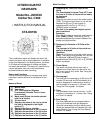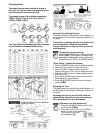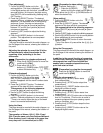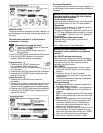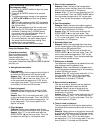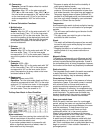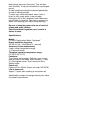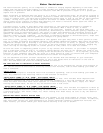
Using the Register Ring
[Calculation function]
Note the following points
when using this function.
Use the calculation
function of this watch only
as a guide. Scales like these cannot, place a decimal
point for you.
A. Navigational calculation
1. Time required
Example: Obtain the time required for the flight of
an aircraft at 180 knots for 450 nautical miles.
Answer: Align “18” on the outer scale with the
SPEED INDEX (▲) on the inner scale. Then, “45”
on the outer scale corresponds to “2:30” on the
inner scale (time scale). Thus, the time required
for the flight is 2 hours and 30 minutes.
2. Knots (air speed)
Example: Obtain the knots (air speed) for 240
nautical miles with a flight time of 1 hour and 20
minutes.
Answer: Align “24” on the outer scale with “1:20”
on the inner scale (time scale). Then, the SPEED
INDEX (▲) on the inner scale corresponds to “18”
on the outer scale. Thus, the air speed for the
flight is 180 knots.
3. Flight distance
Example: Obtain the air distance when the air
speed is 210 knots and the flight time is 40 minutes.
Answer: Align “21” on the outer scale with the
SPEED INDEX (▲) on the inner scale. Thus, the
air distance of the flight is 140 nautical miles.
4. Rate of fuel consumption
Example: Obtain the rate of fuel consumption
(gallons/hour) when the flight time is 30 minutes
and the fuel consumption is 120 gallons.
Answer: Align “12” on the outer scale with the “30”
on the inner scale. Then, the SPEED INDEX (▲) on
the inner scale corresponds to “24” on the outer
scale. Thus, the fuel consumption is 240 gallons
per hour.
5. Fuel Consumption
Example: Obtain the fuel consumption required
for a flight when the fuel consumption is 250 gallons
per hour and the flight time is 6 hours.
Answer: Align “25” on the outer scale with the
SPEED INDEX (▲) on the inner scale. Then,
“6:00” on the inner scale (time scale) corresponds
to “15” on the outer scale. Thus, the fuel
consumption is 1,500 gallons.
6. Estimated flight time
Example: Obtain the estimated flight time when
the fuel consumption is 220 gallons per hour and
the aircraft has 550 gallons of fuel.
Answer: Align “22” on the outer scale with the
SPEED INDEX (▲) on the inner scale. Then, “55”
on the outer scale corresponds to “2:30” on the
inner scale (time scale). Thus, the estimated flight
time is 2 hours and 30 minutes.
7. Differences in altitude
The difference in altitude can be obtained from the
rate of descent and the descent time.
Example: Obtain the difference in altitude when
an aircraft continues descending for 23 minutes at
a rate of 250 feet per minute.
Answer: Align “25” on the outer scale with “10” on
the inner scale. Then, “23” on the inner scale
corresponds to “57.5” on the outer scale. Thus,
the difference in altitude is 5,750 feet.
8. Rate of climb (or descent)
The rate of climb (or descent) can be obtained
from the time required to reach an altitude.
Example: Obtain the rate of climb when an
aircraft reaches an altitude of 7,500 feet after
climbing for 16 minutes.
Answer: Align “75” on the outer scale with the “16”
on the inner scale. Then, “10” on the inner scale
corresponds to “47” on the outer scale. Thus, the
rate of the climb is 470 feet.
9. Time of climb (or descent)
The time required for climb can be obtained from
the altitude to be reached and the rate of climb (or
descent)
Example: Obtain the time of climb when an aircraft
is to climb to 6,300 feet at a rate 550 feet per minute.
Answer: Align “55” on the outer scale with “10” on
the inner scale. Then, “63” on the outer scale
corresponds to “11.5” on the inner scale. Thus, the
time of climb is 11 minutes and 30 seconds.
*Zero positioning can also be done in
Chronograph mode.
1. Press the ࠗ
M (MODE) button to align the mode
hand to [CHR].
2. Press the ࠗ
M (MODE) button to its outward
position.
3. The digital segments change in the sequence
of UTC ➡ HR ➡ MIN each time the ࠗ
B button
is pressed.
UTC: For zero positioning of the UTC time display
HR: For zero positioning of the hour hand and
the 24-hour hand
MIN: For zero positioning of the minute hand
4. Pressing the ࠗ
A (UP) button turns each hand
clockwise. Pressing the ࠗ
C (DOWN) button
turns each hand counterclockwise. Align all
hands to the 12 o’clock position.
5. When the ࠗ
A (UP) button is pushed back in to
this normal position, the watch beeps and at
the same time the hands start moving. Zero
positioning is now completed.
6. Set the time, calendar and other modes.



